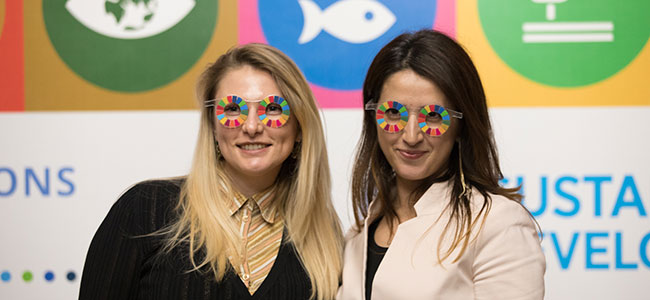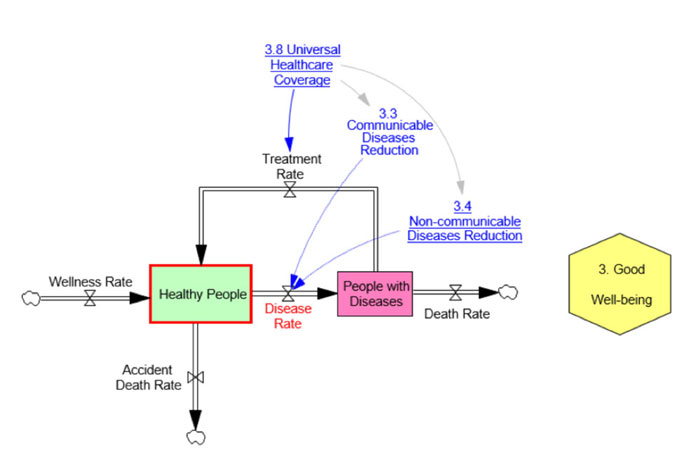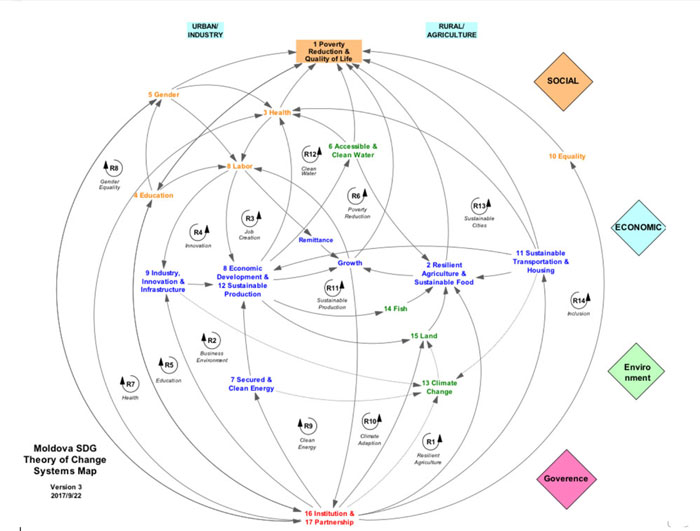By Ana Moraru and Valeriu Prohnitchi
Untangling the complexity of the Sustainable Development Goals in Moldova
November 2, 2018
The Sustainable Development Goals (SDGs) are a beautiful vision for a better world, where people have equal access to food, health, public services, education, equal rights and pay. It’s a world where oceans and air are clean, fish are happy, and forests are preserved. Comprehensive? Certainly. Complex? Beyond any doubt.
No matter how you want to see it, the stakes for achieving the SDGs are high. The clock is ticking. How are governments going to make the SDGs happen in the next 12 years? How do policy makers translate these goals into real outcomes for people?
Look at things differently: think systems
At first glance, it might be tempting to eat the elephant one bite at a time. The standard approach for analysis is to decompose phenomena into manageable pieces, which can be easier to grasp. The puzzle is then solved when all the pieces are put together. With this approach, the whole equals to the sum of the parts. However, this is not the optimal strategy in complex systems, where a standard approach would only encourage silo-based and piecemeal solutions. In complex systems, the uncoordinated actions of actors would result in suboptimal outcomes for the whole systems.
Let’s take Goal 1: No Poverty, for example. How do we expect to achieve Goal 1 without touching upon Goal 3: Good Health and Well-Being or Goal 4: Quality Education?
At the UN in Moldova, we looked at the Global Goals from a different lens, that of multiple causes, effects, feedback loops, and actors. With such an approach, the whole may equal more than the sum of all parts. Our hypothesis was this: by uncovering the fundamental causal loops and relations among the SDG targets, we can help the government and the UN in Moldova identify the “leverage points” – policy priority areas. In turn, this will help us to make progress over multiple goals at once, and prioritize policy actions and investments of scarce resources in the short, medium, and long term.
In our last blog post, we shared our experiences working with the government in ‘Glocalizing’ the Sustainable Goals in Moldova. After that exercise, we supported the Republic of Moldova to update the national strategic planning framework to encompass the SDGs. During the early stages of the strategy development, the apple of discord happened to be a persistent one: among of the many development challenges, how should the government decide which ones to prioritize?
Once again, the systems analysis perspective came in handy.
If we look at SDG targets from the perspective of systems dynamics, we can analyze the connections and the causal and feedback loops among them. Some targets will even prove to be more connected than others; progress on these targets would most likely generate a multiplier effect. We like to call these “SDGs accelerators”, or “leverage points”. If we attained progress on these accelerators, then we would help the country progress on the Global Goals as a whole. This was our theory of change.
It takes a village to raise a child (or a country)
One of the criticisms of the national strategic planning policies is that these don’t reflect the needs of the people and vulnerable groups. This time, as we say in Moldova, we tried to avoid stepping on the same rake twice.
We convened different players, including representatives of ministries, MPs, governmental agencies, civil society organizations, including representatives of vulnerable groups, academia, donors, and development agencies. This process helped us to reach a common vision and understanding that helped us set the priorities for the actual National Development Strategy. The systems thinking approach was helpful, yet again.
What we did to untangle the SDGs
To untangle and analyze the SDGs, we used the stock-and-flow and causal links diagrams, an approach from the field of System Dynamics developed at MIT. Within this analytical framework, a stock of some elements varies due to inflows increasing the stock and outflows diminishing it.
What does this mean exactly? Let’s take Goal 3: Good Health and Well-being (see Figure 1). The rectangle “Healthy People” denotes a stock variable. In systems dynamics, stock variables represent variables that accumulate or that can be depleted. To better understand how it works, imagine a bathtub. The inflow from the “Wellness Rate” increases the stock of “Healthy People”, while the outflow of “Disease Rate” or “Accidental Death Rate“ will decrease the stock because more healthy people will get sick due to diseases or die of accidents over time. Arrows represent a primary or secondary causal direction moving from a cause to an effect.
Figure 1. SDG3: stock-and-flow causal loop diagram. Source: Moldova SDGs system map.
The solid lines conventionally denote that the cause and effect move in the same direction holding all else constant; e.g. an increase in the “3.8 Universal Healthcare Coverage” will cause an increase in the “Treatment Rate”. A dashed line denotes the cause and effect moving in the opposite directions, e.g. an increase in 3.3 Communicable Disease Reduction will decrease the Disease Rate.
In the SDGs complexity mapping, the first major decision was where to begin. In our case, we started with the SDG1: No Poverty, for which we have conducted a prima facie analysis of the immediate causal links (Figure 2). The central stock we are trying increase is “People with Good Quality of Life”. People move from the stocks of “People in Extreme Poverty” to “People in Poverty” and then to “People with Good Quality of Life”, following the flows of 1.1 Extreme Poverty Eradication Rate and 1.2 Poverty Elimination & Quality of Life Improvement Rate.
We then add a new layer of analysis, by incorporating the SDG2: Zero Hunger. The target 2.4 “Resilient Agricultural Practices” shifts the “Vulnerable Food Production” towards “Resilient Agriculture Food Production”. Further on, an increase in “Resilient Agriculture Food Production” will help raise 2.3 “Agricultural Productivity & Incomes of Small-scale Food Producers”, which in turn increases 10.1 “Income Growth of Bottom 40 percent”. Therefore, the resilient agriculture looks like an important poverty reduction strategy and achieving SDG 2: Zero Hunger helps achieving SDG 1: No Poverty having SDG 10: Reduced Inequalities as intermediary.
Layer after layer, we arrive at a densely packed map revealing the most essential mutual influences among the Moldovan SDGs targets and related policies. From this comprehensive exercise, we narrowed down the common vision for Moldova in 2030 to three main poles:
- People with a good quality of life, with decreased emigration and progressive values, have to be put at the centre of the development vision – i.e. development should be for the people rather than by the people.
- Effective, accountable and inclusive institutions able to put an end to corruption are essential for unleashing the potential existing in the wider society.
- Sustainable production and sustainable industrialization is the most promising economic model enabling a decisive and lasting reduction in poverty and in providing equal opportunities for all to achieve high standards of living.
We found some answers and have more questions
Overall, systems analysis proved to be a great method for looking at the big picture. It helped identify the most connected elements which served as a basis for defining the development vision for the National Development Strategy Moldova 2030 and for prioritizing key areas of intervention.
As such, we made the first step towards understanding the causal links between SDG targets. However, what we couldn’t see is how these links reproduce over time. The next step in this analysis would be to check how these links change over time, allowing us to understand the dynamics of the system.
Similarly, we would want to see the strength of the links to understand the magnitude of influence. This would represent a highly ambitious exercise, requiring a different time-frame and more solid data.
Are you trying using a similar approach to untangle the Sustainable Development Goals? Share with us!

 Locations
Locations


